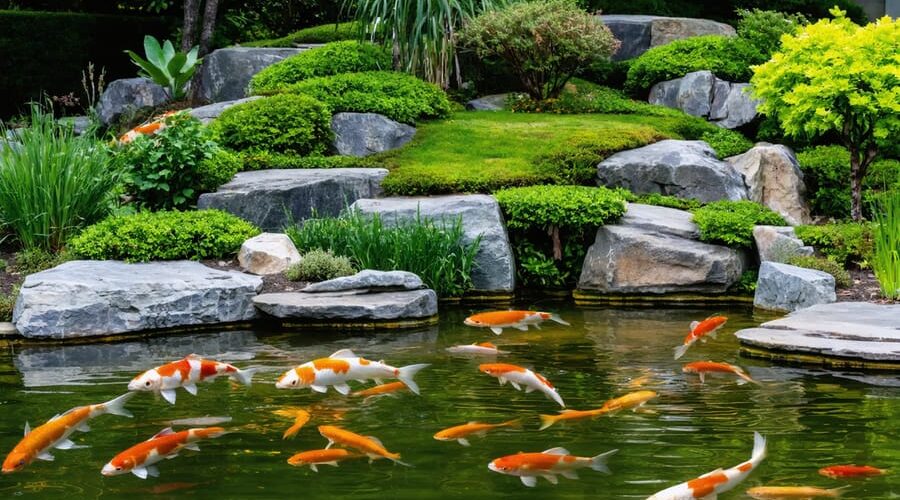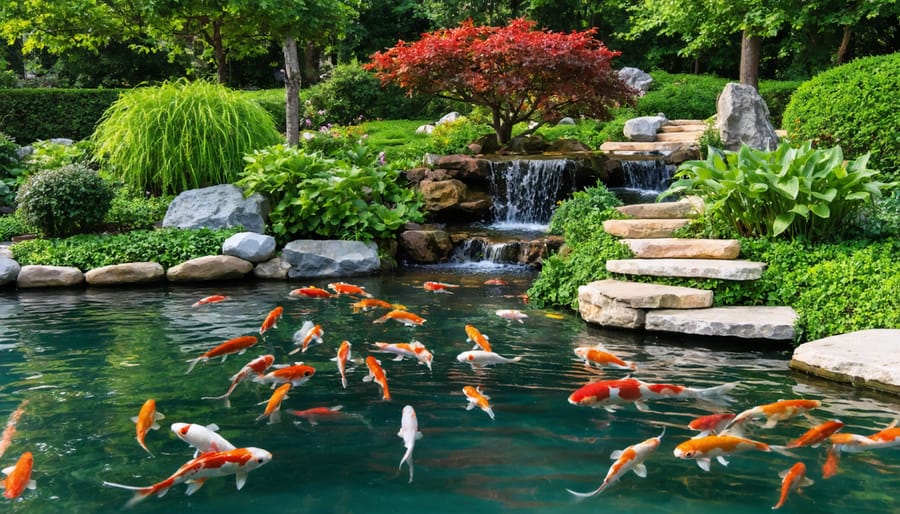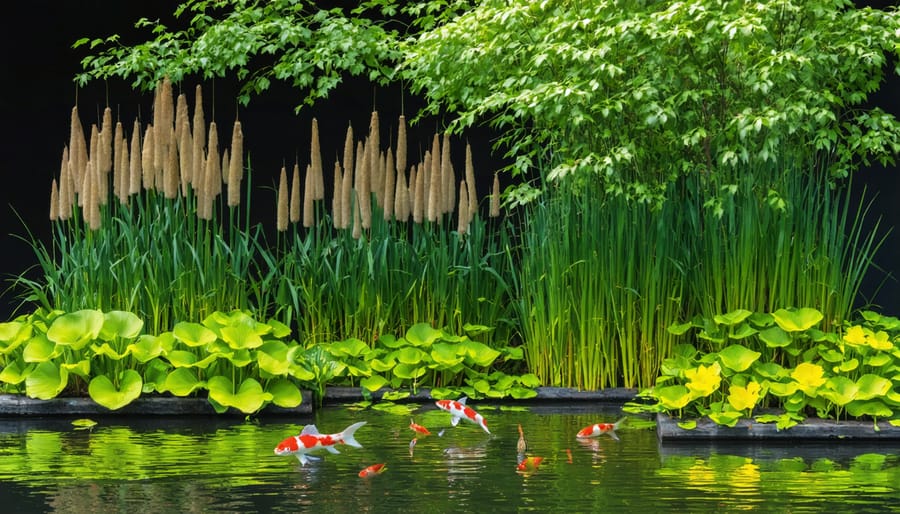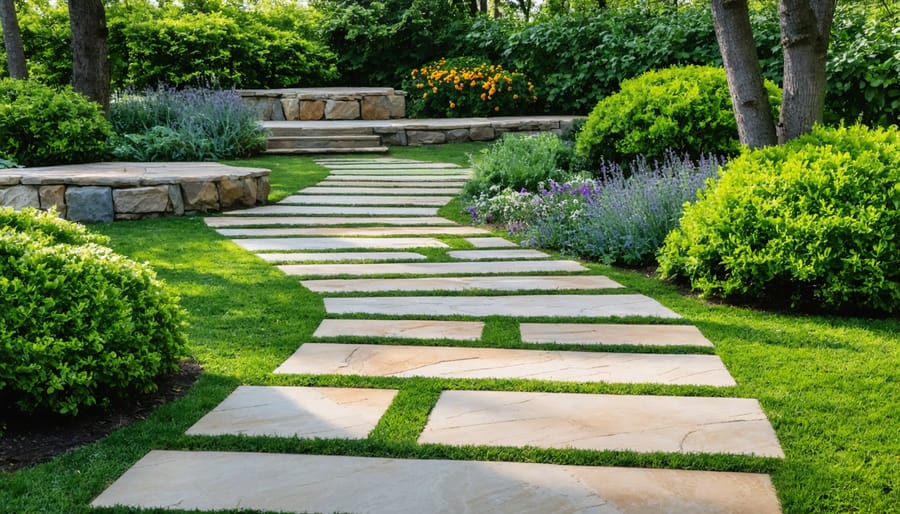
Transform Your Koi Pond into a Living Paradise: Natural Landscaping That Works
Transform your koi pond into a breathtaking waterscape by creating layers of natural beauty that complement your aquatic sanctuary. The right landscaping not only enhances the visual appeal but also plays a crucial role in maintaining the health and stability of your pond ecosystem. From carefully selected marginal plants that filter excess nutrients to strategically placed rocks that prevent soil erosion, every element serves both an aesthetic and practical purpose. Whether you’re starting fresh or renovating an existing pond area, thoughtful landscaping creates a harmonious balance between water and land, providing your koi with a protected environment while offering you a serene retreat that captures the essence of Japanese garden design. The key lies in combining hardy plants, natural materials, and proper elevation changes to craft a sustainable landscape that looks as though it’s always been part of your garden.
Creating the Perfect Foundation
Strategic Elevation Planning
Creating natural elevation changes around your koi pond adds visual interest and serves practical purposes. Start by mapping out gentle slopes that direct rainwater away from the pond to prevent unwanted runoff. A general rule is to create a gradual incline of 1 inch per foot, which looks natural while providing effective drainage.
Build terraces using stacked stones or retaining walls to create different planting zones. These levels not only add depth to your landscape but also provide perfect spots for various plant types. Place moisture-loving plants like iris and cattails near the pond’s edge, while drought-resistant plants work well on higher ground.
Consider incorporating a small waterfall or stream feature into your elevation changes. This not only adds visual appeal but also helps oxygenate the pond water. Use larger rocks and boulders strategically to anchor your slopes and create natural-looking transitions between levels.
Remember to leave some flat areas around the pond for maintenance access and viewing spots. These spaces can be enhanced with gravel paths or stepping stones, making it easier to enjoy your koi from different angles while maintaining the natural flow of your landscape design.
Soil Selection and Preparation
Successful landscaping around your koi pond starts with choosing the right planting media for different areas. For the immediate pond edge, use well-draining soil mixed with gravel to prevent erosion into the water. This area needs stable soil that won’t muddy your pond when it rains.
For marginal plants growing in shallow water, create a mix of heavy garden soil and aquatic planting media. This helps anchor plants while providing necessary nutrients. In the surrounding garden beds, use rich, organic soil amended with compost for lush growth of ornamental plants and ground covers.
Remember to test your soil’s pH, aiming for slightly acidic to neutral (6.0-7.0) for most pond-side plants. Add a layer of mulch around plants, keeping it away from the pond edge to prevent debris from falling into the water. This helps retain moisture and suppress weeds while maintaining a tidy appearance.
For rocky areas or steep slopes, incorporate additional gravel or sand to improve drainage and prevent soil washout during heavy rains.
Plant Selection for Ecological Balance

Shade-Providing Plants
Creating natural shade around your koi pond is essential for maintaining optimal water temperatures and protecting your fish. Japanese maples are perfect choices, offering beautiful color variations while providing dappled shade that won’t overwhelm the pond. Their delicate leaves create stunning reflections on the water’s surface.
For larger spaces, weeping willows make excellent shade providers, with their graceful branches extending over the water. Just be mindful to plant them far enough from the pond to prevent root interference with the liner. Bamboo creates excellent natural screening and shade, while adding a zen-like atmosphere to your pond area.
Consider incorporating tall ornamental grasses like maiden grass or fountain grass around the northern edge of your pond. These provide partial shade without blocking too much sunlight, and their movement adds dynamic interest to your landscape. For immediate shade, fast-growing trees like river birch or dawn redwood can be excellent choices, though ensure they’re planted at a safe distance to prevent leaf litter from overwhelming your pond.
Filtration-Supporting Flora
Plants around your koi pond can do more than just look pretty – they play a vital role in maintaining water quality. Water hyacinths and water lettuce are excellent natural filters, absorbing excess nutrients and helping prevent algae growth. These floating plants provide shade and shelter while cleaning the water through their root systems.
For the pond’s edge, cattails and rushes are fantastic choices. Their extensive root systems act as natural filters, trapping debris and processing organic waste. Iris and pickerelweed are not only beautiful but also help remove nitrogen and other nutrients that could otherwise lead to water quality issues.
Consider adding submerged plants like hornwort or anacharis. These oxygenating plants work beneath the surface, releasing oxygen during the day and absorbing harmful compounds. They’re especially helpful in maintaining clear water and providing a balanced ecosystem for your koi.
Place bog plants like marsh marigold and sweet flag in shallow areas or filter zones. These plants thrive in wet conditions and excel at nutrient absorption. Remember to maintain these filtration-supporting plants by removing dead leaves and dividing them when they become overcrowded. This ensures they continue effectively supporting your pond’s water quality while creating a natural, harmonious environment for your koi.

Protective Border Plants
Creating a protective border around your koi pond isn’t just about aesthetics – it’s about keeping your finned friends safe from predators like herons, raccoons, and cats. Tall, dense plants like bamboo and ornamental grasses create natural barriers that make it harder for predators to spot and access your pond. Japanese forest grass and maiden grass are particularly effective, growing in thick clusters that provide excellent coverage.
Consider planting thorny bushes like barberry or roses around vulnerable areas. These not only add beautiful colors to your landscape but also discourage unwanted visitors from getting too close to the water. For added protection, layer your plantings with different heights – tall grasses at the back, medium-height shrubs in the middle, and lower-growing plants in front.
Hardy perennials like daylilies and iris not only create dense growth but also provide hiding spots for koi when they sense danger. Plant these in groups around the pond’s edge, leaving some open spaces for you to view and feed your fish. For year-round protection, mix in evergreen shrubs like holly or juniper, which maintain their defensive barrier even during winter months.
Just remember to avoid plants that drop excessive leaves or have invasive root systems that could damage your pond liner.
Hardscaping Elements
Natural Stone Selection
Natural stones are the cornerstone of any beautiful koi pond landscape, drawing inspiration from traditional Japanese garden principles. When selecting rocks for your pond area, look for a mix of sizes and shapes that complement each other naturally. Large boulder-type rocks can serve as striking focal points, while smaller stones create natural-looking transitions and ground cover.
Choose rocks native to your region for the most authentic look and better ecological harmony. Smooth, rounded stones are ideal for areas where people might walk, while more angular rocks can create dramatic vertical interest. Remember to include flat stones that slightly overhang the water’s edge – these serve as both aesthetic elements and basking spots for your koi during sunny days.
For the best visual impact, group stones in odd numbers and vary their heights. Place larger rocks partially buried to appear as if they’ve always been there. Avoid using lightweight or porous rocks that might break down in water or affect your pond’s chemistry. Granite, slate, and river rock are excellent choices as they’re durable and won’t alter water quality.
When positioning stones, ensure they’re stable and won’t slide into the pond. Create small terraces or gentle slopes with your rock placement to prevent soil erosion and provide natural planting pockets. This thoughtful arrangement not only looks beautiful but also helps maintain the health of your pond ecosystem.
Viewing Areas and Pathways
Creating comfortable viewing areas around your koi pond allows you to enjoy your aquatic pets while protecting the delicate ecosystem you’ve established. Start by designing raised observation points that keep visitors a few feet back from the pond’s edge, preventing accidental debris from falling into the water and reducing stress on your koi.
Natural stone pathways offer both beauty and functionality, providing stable footing while complementing the pond’s organic appearance. Consider laying these paths at least 18 inches away from the pond’s edge to prevent soil and mulch from washing into the water during rain. For extra protection, install small drainage channels alongside your paths to direct runoff away from the pond.
Create designated seating areas using weather-resistant materials like treated wood or stone benches. Position these spots strategically to catch the best views of your koi while maintaining a respectful distance. Adding subtle lighting along pathways not only enhances safety during evening viewing but also creates a magical atmosphere without disturbing your fish.
For areas closer to the water’s edge, install sturdy stepping stones or a small deck with railings. These features should be slightly elevated above ground level to prevent direct soil contact with the pond. Remember to incorporate non-slip surfaces on all walking areas, especially important during wet weather or morning dew.
By thoughtfully planning your viewing areas and pathways, you’ll create an inviting space that allows everyone to safely enjoy your koi pond while preserving its delicate balance.

Maintaining the Balance
Seasonal Care Routines
Maintaining your koi pond landscape requires different approaches throughout the year to keep it healthy and vibrant. In spring, focus on cleaning up winter debris, pruning dead foliage, and dividing overgrown plants. This is also the perfect time to add new plants and refresh your mulch layer to prevent weed growth.
Summer calls for regular maintenance of your water plants, including removing yellowing leaves and deadheading spent blooms. Keep an eye on water levels and top up when necessary, as plants and evaporation increase water loss. Trim back any overhanging plants that might drop excessive leaves into the pond.
Fall is crucial for preventing leaf buildup in your pond. Install temporary netting above the pond to catch falling leaves, and regularly remove any debris that does make it into the water. Cut back perennials and remove annual plants that won’t survive winter. Apply a fresh layer of mulch to protect plant roots.
Winter preparation involves removing or protecting tender plants, depending on your climate. Consider using a pond heater to maintain a small opening in the ice for gas exchange. Remove pump and filtration systems if needed, based on your winter severity. Keep snow cleared from any decorative structures around the pond to prevent damage from weight buildup.
Remember to adjust your feeding schedule for koi and maintain regular water quality checks throughout all seasons to ensure a healthy ecosystem.
Problem Prevention
Successful koi pond landscaping requires careful attention to prevent common issues that can affect both the pond’s aesthetics and your fish’s health. One of the biggest challenges is preventing debris from entering the pond. Position plants and rocks strategically to catch falling leaves, and consider installing protective netting during autumn months. Creating a self-maintaining ecosystem will significantly reduce maintenance needs.
Watch out for aggressive plant roots that can damage pond liners. Always use root barriers when planting near the pond edge, and regularly check for any signs of liner penetration. Choose plants that won’t spread aggressively or drop excessive debris into the water.
Erosion around the pond edges can be problematic, especially after heavy rains. Prevent this by establishing strong ground cover plants and ensuring proper drainage slopes away from the pond. Install catch basins or french drains if needed to manage water runoff.
Be mindful of chemical runoff from nearby garden areas. Create buffer zones between fertilized areas and your pond, and use only pond-safe products for pest control. Consider raising the pond edges slightly above ground level to prevent contaminated surface water from flowing in.
Finally, protect against predators by incorporating strategic hiding spots for your koi using rocks and plants, while maintaining clear sight lines so you can monitor your fish’s health and activity.
Creating a beautiful landscape around your koi pond is more than just an aesthetic choice – it’s about crafting a harmonious ecosystem that benefits both your fish and your outdoor space. By carefully selecting the right plants, incorporating natural elements like rocks and gravel, and maintaining proper water flow, you can create a stunning water garden that serves as a peaceful retreat in your backyard.
Remember that successful pond landscaping is a journey that evolves over time. Start with a solid plan, but don’t be afraid to make adjustments as you learn what works best for your specific environment. Whether you choose a formal Japanese-inspired design or a more naturalistic approach, the key is to maintain balance between beauty and functionality.
As you begin your landscaping project, take it one step at a time. Start with essential elements like proper filtration and plant shelves, then gradually add decorative touches that reflect your personal style. Keep in mind that your koi will thank you for creating a environment that provides them with shelter, shade, and natural filtration through carefully chosen aquatic plants.
The rewards of a well-landscaped koi pond are truly worth the effort. Not only will you create a stunning focal point for your garden, but you’ll also establish a thriving ecosystem that brings joy and tranquility to your outdoor space for years to come. So grab your gardening tools and let your creativity flow – your perfect koi pond paradise awaits!
